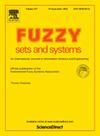基于Pearson相关系数的大规模模糊认知地图学习算法
IF 2.7
1区 数学
Q2 COMPUTER SCIENCE, THEORY & METHODS
引用次数: 0
摘要
模糊认知图是一种可解释的软计算方法。近年来,人们提出了各种算法来自动学习fcm。然而,与真实的fcm相比,用于学习的权重矩阵的密度通常要高得多。此外,从大规模数据中学习因果关系的过程缺乏基于知识的指导,因此有必要主动探索概念节点之间的关系来指导fcm的学习过程。受传统fcm学习算法中专家知识指导的启发,我们提出采用Pearson相关系数(PCC)来指导fcm学习。PCC是一种用于评估两个变量之间线性关系强度的统计度量,它提供了有关关系强度和方向的信息。因此,我们提出了一种新的基于PCC引导的大规模fcm学习算法,称为pcg - fcm。pcg - fcm模型有以下三个术语。第一项是自适应损失函数,以增强模型的鲁棒性。第二项采用11范数来提高权矩阵的稀疏性。第三项是我们提出的PCC指导项,其中我们利用线性方程系统中因变量和自变量之间的PCC来指导fcm的学习。我们使用真实数据和人工数据进行了几次测试。此外,利用pcg - fcm算法重构了基因调控网络。结果表明,该方法具有良好的性能。本文章由计算机程序翻译,如有差异,请以英文原文为准。
Pearson correlation coefficient-guided large-scale fuzzy cognitive maps learning algorithm
Fuzzy cognitive maps (FCMs) are interpretable soft computing methods. In recent years, various algorithms have been proposed for automatically learning FCMs. However, the density of the weight matrix used for learning is often significantly higher compared with real FCMs. Moreover, the process involving learning causal relationships from large-scale data lacks guidance based on knowledge, so it is necessary to proactively explore the relationships between concept nodes to guide the learning process for FCMs. Inspired by the expert knowledge guidance used in the traditional algorithms for learning FCMs, we propose employing Pearson correlation coefficients (PCC) to guide the learning of FCMs. The PCC is a statistical measure used to assess the strength of the linear relationship between two variables, and it provides information about the strength and direction of the relationship. Therefore, we propose a new algorithm for learning large-scale FCMs with PCC guidance called PCCG-FCM. The PCCG-FCM model has the following three terms. The first term is an adaptive loss function to enhance the robustness of the model. The second term employs the -norm to promote the sparsity of the weight matrix. The third term is our proposed PCC-guided term, where we leverage the PCC between the dependent and independent variables in a linear equation system to guide the learning of FCMs. We conducted several tests using real and artificial data. In addition, gene regulatory networks were reconstructed with the PCCG-FCM algorithm. The results showed that the proposed approach performed well.
求助全文
通过发布文献求助,成功后即可免费获取论文全文。
去求助
来源期刊

Fuzzy Sets and Systems
数学-计算机:理论方法
CiteScore
6.50
自引率
17.90%
发文量
321
审稿时长
6.1 months
期刊介绍:
Since its launching in 1978, the journal Fuzzy Sets and Systems has been devoted to the international advancement of the theory and application of fuzzy sets and systems. The theory of fuzzy sets now encompasses a well organized corpus of basic notions including (and not restricted to) aggregation operations, a generalized theory of relations, specific measures of information content, a calculus of fuzzy numbers. Fuzzy sets are also the cornerstone of a non-additive uncertainty theory, namely possibility theory, and of a versatile tool for both linguistic and numerical modeling: fuzzy rule-based systems. Numerous works now combine fuzzy concepts with other scientific disciplines as well as modern technologies.
In mathematics fuzzy sets have triggered new research topics in connection with category theory, topology, algebra, analysis. Fuzzy sets are also part of a recent trend in the study of generalized measures and integrals, and are combined with statistical methods. Furthermore, fuzzy sets have strong logical underpinnings in the tradition of many-valued logics.
 求助内容:
求助内容: 应助结果提醒方式:
应助结果提醒方式:


